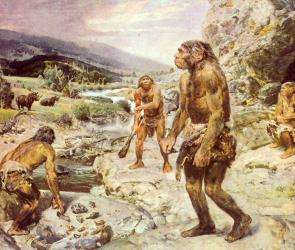Neanderthals different in north, south

A Hull York Medical School (HYMS) researcher has played a key role in a study which has cast important new light on Neanderthals.
Dr Markus Bastir was part of an Anglo-Spanish team which studied 43,000-year-old Neanderthal remains at El Sidrón in Spain, revealing significant physical differences between those from northern and southern Europe.
Dr Bastir, who was based in the functional morphology and evolution research unit of HYMS (fme) for the last two years, analysed the mandibles of Neanderthals discovered at El Sidrón. The analysis revealed north–south variations, with southern European Neanderthals showing broader faces with increased lower facial heights. The research findings are published in the Proceedings of the National Academy of Sciences (PNAS).
It comes as the University of Hull's Centre for Medical Engineering and Technology (CMET), in which the fme is a partner, carried out detailed imaging of part of the upper jaw of what could be Britain's most substantial Neanderthal fossil discovered at Kent's Cavern in Torbay in 1926. The imaging using CMET's micro Computerised Tomography facilities was carried out on behalf of the Natural History Museum's Ancient Occupation of Britain project supported by the Leverhulme Trust.
Dr Bastir first studied the facial evolution of Neanderthals while at the Museo Nacional de Ciencias Naturales in Madrid. Later in the fme at HYMS, he analysed the mandibles of the El Sidrón remains, under the supervision of Professor Paul O'Higgins, using 3D geometric morphometric software and imaging facilities.
"This revealed an astonishing North-South morphological gradient and gives us an idea of typically Southern-European Neanderthal facial shape," Dr Bastir said.
Professor O'Higgins said the two studies helped to demonstrate the growing importance of the HYMS functional morphology and evolution Unit, which has been established with more than £3million funding support from the Leverhulme Trust, the European Union, the Australian Research Council, the Natural Environment Research Council (NERC), Biotechnology and Biosciences Research Council (BBSRC) and the Arts and Humanities Research Council (AHRC).
"At York we have developed an exciting collaboration with colleagues from the Department of Archaeology to form PALAEO -- the Centre for Human Palaeoecology and Evolutionary Origins, while at Hull we have formed a partnership with colleagues in Engineering and Computer Science in establishing the Centre for Medical Engineering and Technology," he added.
"Through the grant support we have raised we have been able to pick the best students and post doctoral fellows from Europe and more widely bringing them to Hull and York to work on leading edge issues in our field."
Source: University of York





















